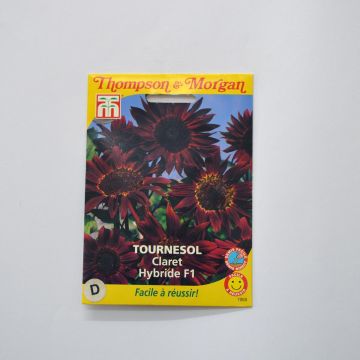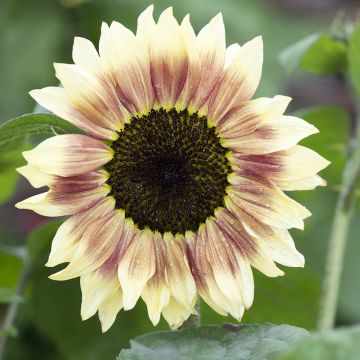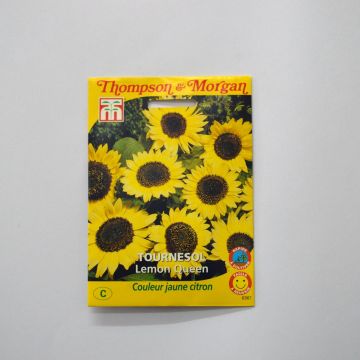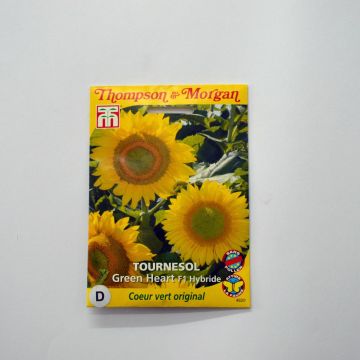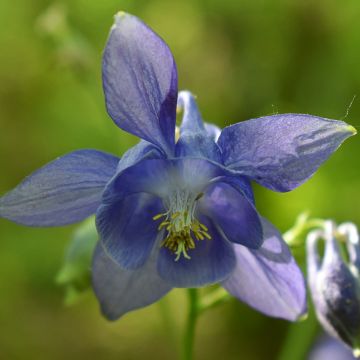Shipping country and language
Your country of residence may be:
Your country of residence is:
For a better user experience on our website, you can select:
Your shipping country:
Andorra
Austria
Belgium
Bulgaria
Canada
Chile
Croatia
Cyprus
Czechia
Denmark
Estonia
Finland
France
Germany
Greece
Hungary
Iceland
Ireland
Italy
Latvia
Lithuania
Luxembourg
Malta
Monaco
Netherlands
Poland
Portugal
Romania
Slovakia
Slovenia
Spain
Sweden
Switzerland
United Kingdom
We only deliver seed and bulb products to your country. If you add other products to your basket, they cannot be shipped.
Language:
French
German
Spanish
English
My Account
Hello
My wish lists
Plantfit
Log in / Register
Existing customer?
New customer?
Create an account to track your orders, access our customer service and, if you wish, make the most of our upcoming offers.


Tournesol Prado Red - Helianthus annuus
Sunflower Prado Red seeds - Helianthus annuus
Helianthus annuus Prado Red
Sunflower, Common Sunflower
Not red like in the photo. Dark colour with yellow veins. Height 60cm (24in). Numerous flowers per stem. A bit commonplace.
Marlyse, 25/02/2019
Why not try an alternative variety in stock?
View all →Order in the next for dispatch today!
Dispatch by letter from €3.90.
Delivery charge from €5.90 Oversize package delivery charge from €6.90.
More information
This item is not available in your country.
Schedule delivery date,
and select date in basket
This plant carries a 6 months recovery warranty
More information
We guarantee the quality of our plants for a full growing cycle, and will replace at our expense any plant that fails to recover under normal climatic and planting conditions.
Seed-only orders are dispatched by sealed envelope. The delivery charge for seed-only orders is €3.90.
Does this plant fit my garden?
Set up your Plantfit profile →
Description
Helianthus annuus 'Prado Red', or Red Garden Sunflower, is a fast-growing annual plant with strong branching stems that reach up to 1.20m (4ft) and bear up to 20 red flowers with almost black brown hearts. This creates the effect of real giant flower bouquets!
Its flowers resemble giant daisies measuring 15 to 20cm (6 to 8in) in diameter. A double row of red petals surrounds the heart of the flower, which has a fine golden yellow edge and a nearly black brown colour.
The main stem branches out and bears a flower at each of its ends, which does not bend as easily as other varieties. The branches are long enough to be picked individually and create magnificent summer bouquets.
Selected by professionals in the cut flower industry, the Prado Red Sunflower does not produce pollen. It will therefore not stain furniture and clothing.
This magnificent flowering lasts from July to October. However, we recommend staggering your sowings to enjoy beautiful and young flowers regularly.
To enjoy your Sunflower bouquets for longer, follow these tips:
Cut the flowers in the morning just after they have opened. Use a knife that has been thoroughly cleaned beforehand. Remove the leaves starting from the bottom, leaving only 2 or 3 leaves below the flower. Change the water in the vase every day with fresh water.
In the garden, sow 'Prado Red' in the back of the flower bed, where it will majestically dominate the other flowers.
Until before flowering, the plant optimizes its growth by following the sun's course. This phenomenon, called heliotropism, has given rise to some of its common names: Heliotrope, Sunflower, Sunflower, Red Garden Sunflower.
In terms of ecology:
The melliferous flowers will attract butterflies and pollinating insects to your garden.
The oil-rich seeds are particularly appreciated by birds (Parrots, Tits, etc.). At the end of flowering, harvest them to make some creatures happy during the winter shortage.
Flowering
Foliage
Plant habit
Botanical data
Helianthus
annuus
Prado Red
Asteraceae
Sunflower, Common Sunflower
Cultivar or hybrid
Other Sunflower seeds
Planting and care
The Sunflower can be sown: either in March-April, in buckets under cover, to prepare young plants that can be planted in your flowerbeds after the last frost. Or from April to June, after the frost, directly in place. In a sunny spot in your garden. To enjoy beautiful fresh flowers throughout the season, we recommend staggered sowings as much as possible. Sow your seeds in groups of 2 at a depth of 1cm (0in) and spaced 50cm (20in) apart. After 20 days, remove the weaker shoot to keep only one per location. To promote branching of the main stem, you can cut the terminal bud when the plant has developed its fifth leaf. The vigorous growth of the Sunflower will require regular watering. When the plant reaches about 1m (3ft), watering can be stopped and it can rely on rain, even if it is scarce. It takes about 60 days between sowing and flowering. Protect your seedlings from attacks by snails and slugs, which are fond of these young plants.
Sowing period
Intended location
- , onOrder confirmed
Reply from on Promesse de fleurs
Flower seeds
Haven't found what you were looking for?
Hardiness is the lowest winter temperature a plant can endure without suffering serious damage or even dying. However, hardiness is affected by location (a sheltered area, such as a patio), protection (winter cover) and soil type (hardiness is improved by well-drained soil).

Photo Sharing Terms & Conditions
In order to encourage gardeners to interact and share their experiences, Promesse de fleurs offers various media enabling content to be uploaded onto its Site - in particular via the ‘Photo sharing’ module.
The User agrees to refrain from:
- Posting any content that is illegal, prejudicial, insulting, racist, inciteful to hatred, revisionist, contrary to public decency, that infringes on privacy or on the privacy rights of third parties, in particular the publicity rights of persons and goods, intellectual property rights, or the right to privacy.
- Submitting content on behalf of a third party;
- Impersonate the identity of a third party and/or publish any personal information about a third party;
In general, the User undertakes to refrain from any unethical behaviour.
All Content (in particular text, comments, files, images, photos, videos, creative works, etc.), which may be subject to property or intellectual property rights, image or other private rights, shall remain the property of the User, subject to the limited rights granted by the terms of the licence granted by Promesse de fleurs as stated below. Users are at liberty to publish or not to publish such Content on the Site, notably via the ‘Photo Sharing’ facility, and accept that this Content shall be made public and freely accessible, notably on the Internet.
Users further acknowledge, undertake to have ,and guarantee that they hold all necessary rights and permissions to publish such material on the Site, in particular with regard to the legislation in force pertaining to any privacy, property, intellectual property, image, or contractual rights, or rights of any other nature. By publishing such Content on the Site, Users acknowledge accepting full liability as publishers of the Content within the meaning of the law, and grant Promesse de fleurs, free of charge, an inclusive, worldwide licence for the said Content for the entire duration of its publication, including all reproduction, representation, up/downloading, displaying, performing, transmission, and storage rights.
Users also grant permission for their name to be linked to the Content and accept that this link may not always be made available.
By engaging in posting material, Users consent to their Content becoming automatically accessible on the Internet, in particular on other sites and/or blogs and/or web pages of the Promesse de fleurs site, including in particular social pages and the Promesse de fleurs catalogue.
Users may secure the removal of entrusted content free of charge by issuing a simple request via our contact form.
The flowering period indicated on our website applies to countries and regions located in USDA zone 8 (France, the United Kingdom, Ireland, the Netherlands, etc.)
It will vary according to where you live:
- In zones 9 to 10 (Italy, Spain, Greece, etc.), flowering will occur about 2 to 4 weeks earlier.
- In zones 6 to 7 (Germany, Poland, Slovenia, and lower mountainous regions), flowering will be delayed by 2 to 3 weeks.
- In zone 5 (Central Europe, Scandinavia), blooming will be delayed by 3 to 5 weeks.
In temperate climates, pruning of spring-flowering shrubs (forsythia, spireas, etc.) should be done just after flowering.
Pruning of summer-flowering shrubs (Indian Lilac, Perovskia, etc.) can be done in winter or spring.
In cold regions as well as with frost-sensitive plants, avoid pruning too early when severe frosts may still occur.
The planting period indicated on our website applies to countries and regions located in USDA zone 8 (France, United Kingdom, Ireland, Netherlands).
It will vary according to where you live:
- In Mediterranean zones (Marseille, Madrid, Milan, etc.), autumn and winter are the best planting periods.
- In continental zones (Strasbourg, Munich, Vienna, etc.), delay planting by 2 to 3 weeks in spring and bring it forward by 2 to 4 weeks in autumn.
- In mountainous regions (the Alps, Pyrenees, Carpathians, etc.), it is best to plant in late spring (May-June) or late summer (August-September).
The harvesting period indicated on our website applies to countries and regions in USDA zone 8 (France, England, Ireland, the Netherlands).
In colder areas (Scandinavia, Poland, Austria...) fruit and vegetable harvests are likely to be delayed by 3-4 weeks.
In warmer areas (Italy, Spain, Greece, etc.), harvesting will probably take place earlier, depending on weather conditions.
The sowing periods indicated on our website apply to countries and regions within USDA Zone 8 (France, UK, Ireland, Netherlands).
In colder areas (Scandinavia, Poland, Austria...), delay any outdoor sowing by 3-4 weeks, or sow under glass.
In warmer climes (Italy, Spain, Greece, etc.), bring outdoor sowing forward by a few weeks.


